国际会议论文格式要求,基本要求
国际会议(澳门)的论文格式要求

第十四届国际汉语教学学术研讨会论文体例一、文档:请提供使用Word 编辑的电子文件。
二、篇幅:论文无论使用中文或英文篇幅不设限制。
页面周边空白处均为一英寸(即2.54厘米),内容提要中文150个汉字以内,英文提要80个单词以内,作者简介50个汉字以内。
三、各项内容顺序:论文标题、(国家或地区)作者姓名、单位、内容提要、关键词、英文标题、英文姓名及单位、英文内容提要、英文关键词、正文、注释、参考文献、作者简介。
(注:英文论文则英文标题等在前,中文标题等在后。
)四、字体和字号:论文题目用小二号(18 pts)宋体,英文用Times New Roman 18;作者、单位、内容提要及关键词用五号(10.5 pts)仿宋字体,“内容提要”和“关键词”几个字加粗,英文用Times New Roman;中文正文用五号(10.5 pts)宋体,英文正文用Times New Roman 10.5 pts;一级标题用小四号(12 pts)仿宋体,英文用Times New Roman 12 pts;二级标题用五号(10.5 pts)黑体,英文用Arial 10.5 pts;三级标题用五号(10.5 pts)楷体,英文用Calibri 10.5 pts;注释和参考文献用小五号(9 pts)宋体; 英文用Times New Roman 9 pts;作者简介用小五号(9 pts)仿宋体, 英文用New Courier 9 pts。
五、标题编号:正文中所有的标题均需独占一行,任何级次的标题均需列出具体的标题题目。
序号使用格式为:一级标题用汉字“一、二、……”,居中排列,上下各空一行;二级标题用“(一)(二)(三)……”,前空两汉字格;三级标题用“1、2、3、……”,前空两汉字格。
六、例句和图表:独立列出的例句用五号楷体,编号采用(1)(2)(3)的形式,全文所有例句连续编号。
文中如有图表,请给图和表分别编号,即:图1、图2、……;表1、表2……。
会议论文格式范文
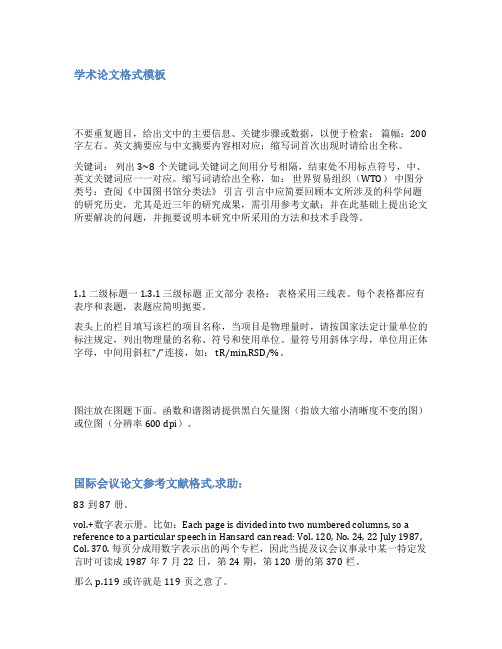
学术论文格式模板不要重复题目,给出文中的主要信息、关键步骤或数据,以便于检索;篇幅:200 字左右。
英文摘要应与中文摘要内容相对应;缩写词首次出现时请给出全称。
关键词:列出3~8个关键词.关键词之间用分号相隔,结束处不用标点符号,中、英文关键词应一一对应。
缩写词请给出全称,如:世界贸易组织(WTO)中图分类号:查阅《中国图书馆分类法》引言引言中应简要回顾本文所涉及的科学问题的研究历史,尤其是近三年的研究成果,需引用参考文献;并在此基础上提出论文所要解决的问题,并扼要说明本研究中所采用的方法和技术手段等。
1.1 二级标题一 1.3.1 三级标题正文部分表格:表格采用三线表。
每个表格都应有表序和表题,表题应简明扼要。
表头上的栏目填写该栏的项目名称,当项目是物理量时,请按国家法定计量单位的标注规定,列出物理量的名称、符号和使用单位。
量符号用斜体字母,单位用正体字母,中间用斜杠“/”连接,如: tR/min,RSD/%。
图注放在图题下面。
函数和谱图请提供黑白矢量图(指放大缩小清晰度不变的图)或位图(分辨率600 dpi)。
国际会议论文参考文献格式,求助:83到87册。
vol.+数字表示册。
比如:Each page is divided into two numbered columns, so a reference to a particular speech in Hansard can read: Vol. 120, No. 24, 22 July 1987, Col. 370. 每页分成用数字表示出的两个专栏,因此当提及议会议事录中某一特定发言时可读成1987年7月22日,第24期,第120册的第370栏。
那么p.119或许就是119页之意了。
会议论文的引用格式是什么我还没有毕业,也没有经历过像你所说的那些事,所以。
2.2 页眉:页眉从摘要页开始到论文最后一页,均需设置。
页眉内容:浙江广播电视大学汉语言文学类本科毕业论文,居中,打印字号为5号宋体,页眉之下有一条下划线。
国际会议论文格式(中文)

论文题目(格式:论文题目格式)副标题(如果有的话用“副标题”格式)第一作者姓名第二作者姓名第一行:部门名称第一行部门名称第二行:组织名称,缩写词第二行:组织名称,缩写词第三行:城市,国家第三行:城市,国家第四行:电子邮件(若有要求的话)电子邮件(若有要求的话)摘要—本电子文档是一个“活”的模板,论文的各个组成部分(题目,正文,标题等)已经在样式表中定义,在本文档也给出了阐明。
(摘要)关键词–组成;格式;字体,式样,插入图(关键词)I.绪论(一级标题)这个模板是在计算机上用Word2003编辑并以“Word 97-2003 & 6.0/95 –RTF”保存的,为作者提供了准备电子版论文所需要的格式规范。
所有的标准论文组成都以3个目的详细介绍:(1)更容易格式化个人论文,(2)自动遵守电子版要求来保证一致或促进随后的电子产品的出版,(3)会议集的格式一致。
页边距,列宽,行距和字体类型都已经内置;本文提供的类型样式的例子是在后面圆括号内以斜体区分的。
某些部分,例如多层次方程,图形和表格都没有规定,只规定了表格中文本的格式,格式化程序还需要创建这些部分来并入标准。
II.常用的选择一个模板(二级标题)首先,保证论文选用了正确的模板,这个模板是在A4纸上编辑的,如果你用的是美信版式,请下载“MSW USltr format”格式的文件。
保持规范的完整性这个模板用来格式化你的论文和文本风格。
页边距,列宽,行距和文本字体都已规定,请不要更改他们。
你可能注意到一些特点,例如,这个模板的标题边距采用习惯性的对称。
这些措施都是故意的,意在把你的论文看做整个论文集的一部分,而不是独立的一篇,请不要更改当前的制定。
III.更改类型前做的准备开始格式化论文前,首先把内容保存为一个独立的文本文件。
等到文本文件格式化完后,再把文本文件和图形文件放在一起。
不要强制使用制表位,并限制回车的强制使用,只有在图片的末尾回车一次。
论文格式要求及字体大小
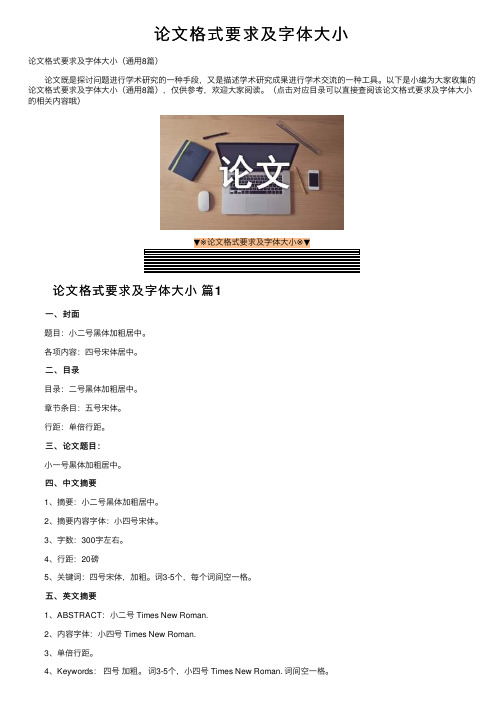
论⽂格式要求及字体⼤⼩论⽂格式要求及字体⼤⼩(通⽤8篇) 论⽂既是探讨问题进⾏学术研究的⼀种⼿段,⼜是描述学术研究成果进⾏学术交流的⼀种⼯具。
以下是⼩编为⼤家收集的论⽂格式要求及字体⼤⼩(通⽤8篇),仅供参考,欢迎⼤家阅读。
(点击对应⽬录可以直接查阅该论⽂格式要求及字体⼤⼩的相关内容哦)▼※论⽂格式要求及字体⼤⼩※▼论⽂格式要求及字体⼤⼩篇1 ⼀、封⾯ 题⽬:⼩⼆号⿊体加粗居中。
各项内容:四号宋体居中。
⼆、⽬录 ⽬录:⼆号⿊体加粗居中。
章节条⽬:五号宋体。
⾏距:单倍⾏距。
三、论⽂题⽬: ⼩⼀号⿊体加粗居中。
四、中⽂摘要 1、摘要:⼩⼆号⿊体加粗居中。
2、摘要内容字体:⼩四号宋体。
3、字数:300字左右。
4、⾏距:20磅 5、关键词:四号宋体,加粗。
词3-5个,每个词间空⼀格。
五、英⽂摘要 1、ABSTRACT:⼩⼆号 Times New Roman. 2、内容字体:⼩四号 Times New Roman. 3、单倍⾏距。
4、Keywords:四号加粗。
词3-5个,⼩四号 Times New Roman. 词间空⼀格。
六、绪论 ⼩⼆号⿊体加粗居中。
内容500字左右,⼩四号宋体,⾏距:20磅 七、正⽂ (⼀)正⽂⽤⼩四号宋体 (⼆)安保、管理类毕业论⽂各章节按照⼀、⼆、三、四、五级标题序号字体格式 章:标题⼩⼆号⿊体,加粗,居中。
节:标题⼩三号⿊体,加粗,居中。
⼀级标题序号如:⼀、⼆、三、标题四号⿊体,加粗,顶格。
⼆级标题序号如:(⼀)(⼆)(三)标题⼩四号宋体,不加粗,顶格。
三级标题序号如:1.2.3.标题⼩四号宋体,不加粗,缩进⼆个字。
四级标题序号如:(1)(2)(3)标题⼩四号宋体,不加粗,缩进⼆个字。
五级标题序号如:①②③标题⼩四号宋体,不加粗,缩进⼆个字。
医学、体育类毕业论⽂各章序号⽤阿拉伯数字编码,层次格式为:1xxxx(⼩2号⿊体,居中)xxxxxxxxxxxxxx(内容⽤4号宋体)。
会议论文书写格式要求

spie会议论文格式

spie会议论文格式spie会是美国的一个非营利性专业组织,每年召开约80 个学术会议,它的论文格式是怎么样的呢?下面是小编精心推荐的一些spie会议论文格式,希望你能有所感触!spie会议论文格式1、题目:应简洁、明确、有概括性,字数不宜超过20个字。
2、摘要:要有高度的概括力,语言精练、明确,中文摘要约100—200字;3、关键词:从论文标题或正文中挑选3~5个最能表达主要内容的词作为关键词。
4、目录:写出目录,标明页码。
5、正文:论文正文字数一般应在3000字以上。
论文正文:包括前言、本论、结论三个部分。
前言(引言)是论文的开头部分,主要说明论文写作的目的、现实意义、对所研究问题的认识,并提出论文的中心论点等。
前言要写得简明扼要,篇幅不要太长。
本论是论文的主体,包括研究内容与方法、实验材料、实验结果与分析(讨论)等。
在本部分要运用各方面的研究方法和实验结果,分析问题,论证观点,尽量反映出自己的科研能力和学术水平。
结论是论文的收尾部分,是围绕本论所作的结束语。
其基本的要点就是总结全文,加深题意。
6、谢辞:简述自己通过做论文的体会,并应对指导教师和协助完成论文的有关人员表示谢意。
7、参考文献:在论文末尾要列出在论文中参考过的专著、论文及其他资料,所列参考文献应按文中参考或引证的先后顺序排列。
8、注释:在论文写作过程中,有些问题需要在正文之外加以阐述和说明。
9、附录:对于一些不宜放在正文中,但有参考价值的内容,可编入附录中。
关于国际光学工程学会的论文范文工程光学多元化教学模式研究摘要:本文通过对工程光学多元化教学模式现状以及存在问题的分析,提出在实施工程光学多元化教学模式过程中,要大力创新引导教学模式和试验教学模式。
实施工程光学多元化教学模式,是我国教学体制改革和新课程改革的内在要求,需要广大工程光学教师持续不断的实施和探索。
随着“新课改”的深入实施,工程光学多元化教学模式必将得到更加广泛的应用。
ieee参考文献格式要求
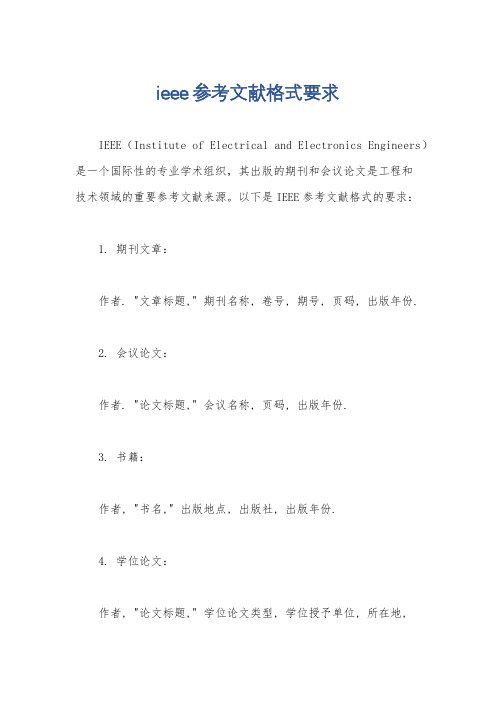
ieee参考文献格式要求
IEEE(Institute of Electrical and Electronics Engineers)是一个国际性的专业学术组织,其出版的期刊和会议论文是工程和
技术领域的重要参考文献来源。
以下是IEEE参考文献格式的要求:
1. 期刊文章:
作者. "文章标题," 期刊名称, 卷号, 期号, 页码, 出版年份.
2. 会议论文:
作者. "论文标题," 会议名称, 页码, 出版年份.
3. 书籍:
作者, "书名," 出版地点, 出版社, 出版年份.
4. 学位论文:
作者, "论文标题," 学位论文类型, 学位授予单位, 所在地,
年份.
5. 报告:
作者, "报告标题," 报告类型, 报告号, 出版地点, 出版机构, 出版年份.
6. 网络资源:
作者(如果有), "文档标题," 网站名称, 网址, 访问日期.
需要注意的是,以上仅是IEEE参考文献格式的基本要求,具体的格式还取决于文献类型和出版物的要求。
在引用参考文献时,应该使用数字标注法,将文献引用编号放在方括号内,按照引用的顺序编排。
此外,IEEE还有一些特殊情况的参考文献格式要求,如专利、标准、手册等,可以在IEEE官方网站或相关文献样例中找到详细的说明和示例。
总之,遵循IEEE参考文献格式的要求可以确保文献引用的准确性和规范性,有助于读者准确找到引用的文献来源。
最全的会议论文格式要求
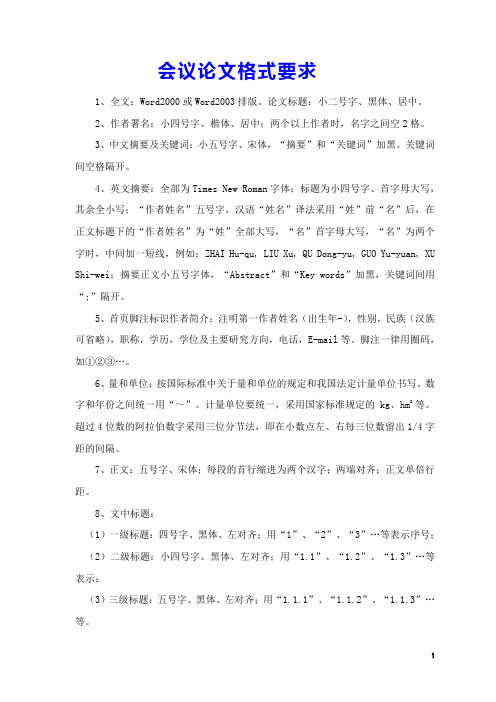
会议论文格式要求1、全文:Word2000或Word2003排版。
论文标题:小二号字、黑体、居中。
2、作者署名:小四号字、楷体、居中;两个以上作者时,名字之间空2格。
3、中文摘要及关键词:小五号字、宋体,“摘要”和“关键词”加黑。
关键词间空格隔开。
4、英文摘要:全部为Times New Roman字体;标题为小四号字、首字母大写,其余全小写;“作者姓名”五号字,汉语“姓名”译法采用“姓”前“名”后,在正文标题下的“作者姓名”为“姓”全部大写,“名”首字母大写,“名”为两个字时,中间加一短线,例如:ZHAI Hu-qu, LIU Xu, QU Dong-yu, GUO Yu-yuan, XU Shi-wei;摘要正文小五号字体,“Abstract”和“Key words”加黑,关键词间用“;”隔开。
5、首页脚注标识作者简介:注明第一作者姓名(出生年-),性别,民族(汉族可省略),职称,学历,学位及主要研究方向,电话,E-mail等。
脚注一律用圈码,如①②③…。
6、量和单位:按国际标准中关于量和单位的规定和我国法定计量单位书写。
数字和年份之间统一用“~”。
计量单位要统一,采用国家标准规定的kg、hm2等。
超过4位数的阿拉伯数字采用三位分节法,即在小数点左、右每三位数留出1/4字距的间隔。
7、正文:五号字、宋体;每段的首行缩进为两个汉字;两端对齐;正文单倍行距。
8、文中标题:(1)一级标题:四号字、黑体、左对齐;用“1”、“2”、“3”…等表示序号;(2)二级标题:小四号字、黑体、左对齐;用“1.1”、“1.2”、“1.3”…等表示;(3)三级标题:五号字、黑体、左对齐;用“1.1.1”、“1.1.2”、“1.1.3”…等。
所有标题后空一格,写标题名。
9、图表要求:图表题黑体、小五号字。
表一律用三线表。
Excel作图要带数据源。
图中所用文字一律用8号字(非“八号”字)。
中文用宋体,英文、数字用Times New Roman。
2012中国能源学会 国际会议 投稿论文写作要求(IEEE CS 格

2012中国能源学会国际会议投稿论文写作要求(IEEE CS 格式)0. 特别提示:请大家使用IEEE CS 最新版的两栏格式模板进行排版格式处理,同时考虑将论文压缩在IEEE CS 的5 页之内,如超过5 页,超出页数将会加收额外费用。
下面是一些中国作者排版时应该注意的问题,请准备论文投稿时注意。
1. 标题(Title): 标题又称题目,是以最恰当、最简明的词语反映论文中最重要的特定内容的逻辑组合。
论文题目是一篇论文给出的涉及论文范围与水平的第一个重要信息。
论文题目十分重要,必须用心斟酌选定,有人说:好的论文题目是好文章的一半。
对论文题目的要求是:准确得体、简短精炼、外延和内涵恰如其分、醒目。
在本次的会议论文中,请使用14 点(14-point) 粗体罗马字(Time New Roman, boldface type) ,标题应居中显示,每个实词(包括名词、代词、动词、形容词和副词)的首字母应该大写,虚词(包括冠词、连词、介词等),注意如果虚词是标题的首个单词,也应该大写,如“A Support Vector Machines Method for Classification Problem”,标题之后留一个10 点字体的空行。
另外,根据以前会议审稿结果,一些标题中还有“Study on ”或者“Research on ”类似的词,应该全部去掉,审稿人认为那些是典型的中国式英语翻译,为了顺利帮助检索,英文的写作应该更符合英文的习惯。
注意:标题字体应该严格按照修改要求来做,不要擅自更改标题字体。
特别长的标题宜分成2 行或者3 行,如果距离过宽,请修改段前距离(在word 的“格式--段落”菜单中可以修改段前段后距离),这样就可以缩小行距。
尽量用“Times New Roman”,不要对这个字体进行压缩。
此外,首页标题不要用下标,表示基金感谢放在Conclusion 之后和“References”之前,设置“Acknowledgment ”一节,对一些基金支持和别人提供的帮助等表示感谢。
国际会议论文投稿要求及格式
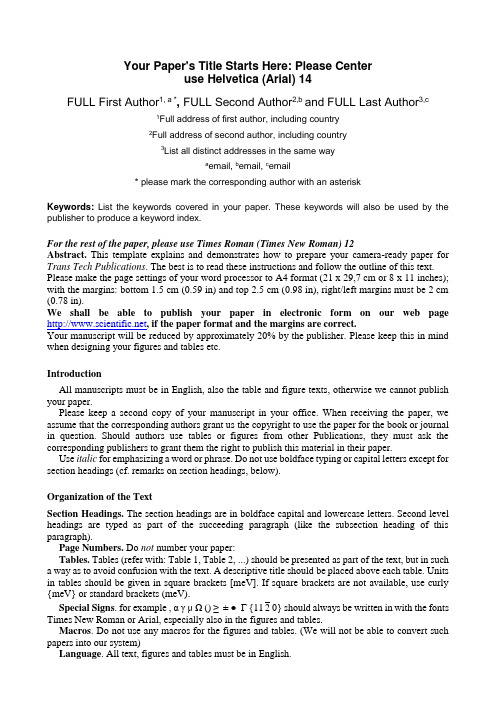
Your Paper's Title Starts Here: Please Centeruse Helvetica (Arial) 14FULL First Author1, a *, FULL Second Author2,b and FULL Last Author3,c1Full address of first author, including country2Full address of second author, including country3List all distinct addresses in the same waya email,b email,c email* please mark the corresponding author with an asteriskKeywords:List the keywords covered in your paper. These keywords will also be used by the publisher to produce a keyword index.For the rest of the paper, please use Times Roman (Times New Roman) 12Abstract.This template explains and demonstrates how to prepare your camera-ready paper for Trans Tech Publications. The best is to read these instructions and follow the outline of this text. Please make the page settings of your word processor to A4 format (21 x 29,7 cm or 8 x 11 inches); with the margins: bottom 1.5 cm (0.59 in) and top 2.5 cm (0.98 in), right/left margins must be 2 cm (0.78 in).We shall be able to publish your paper in electronic form on our web page , if the paper format and the margins are correct.Your manuscript will be reduced by approximately 20% by the publisher. Please keep this in mind when designing your figures and tables etc.IntroductionAll manuscripts must be in English, also the table and figure texts, otherwise we cannot publish your paper.Please keep a second copy of your manuscript in your office. When receiving the paper, we assume that the corresponding authors grant us the copyright to use the paper for the book or journal in question. Should authors use tables or figures from other Publications, they must ask the corresponding publishers to grant them the right to publish this material in their paper.Use italic for emphasizing a word or phrase. Do not use boldface typing or capital letters except for section headings (cf. remarks on section headings, below).Organization of the TextSection Headings. The section headings are in boldface capital and lowercase letters. Second level headings are typed as part of the succeeding paragraph (like the subsection heading of this paragraph).Page Numbers. Do not number your paper:Tables. Tables (refer with: Table 1, Table 2, ...) should be presented as part of the text, but in such a way as to avoid confusion with the text. A descriptive title should be placed above each table. Units in tables should be given in square brackets [meV]. If square brackets are not available, use curly {meV} or standard brackets (meV).Special Signs. for example , αγμΩ () ≥ ± ● Γ {1120}should always be written in with the fonts Times New Roman or Arial, especially also in the figures and tables.Macros. Do not use any macros for the figures and tables. (We will not be able to convert such papers into our system)Language. All text, figures and tables must be in English.Figures. Figures (refer with: Fig. 1, Fig. 2, ...) also should be presented as part of the text, leaving enough space so that the caption will not be confused with the text. The caption should be self-contained and placed below or beside the figure. Generally, only original drawings or photographic reproductions are acceptable. Only very good photocopies are acceptable. Utmost care must be taken to insert the figures in correct alignment with the text. Half-tone pictures should be in the form of glossy prints. If possible, please include your figures as graphic images in the electronic version. For best quality the pictures should have a resolution of 300 dpi(dots per inch).Color figures are welcome for the online version of the journal. Generally, these figures will be reduced to black and white for the print version. The author should indicate on the checklist if he wishes to have them printed in full color and make the necessary payments in advance.Equations. Equations (refer with: Eq. 1, Eq. 2, ...) should be indented 5 mm (0.2"). There should be one line of space above the equation and one line of space below it before the text continues. The equations have to be numbered sequentially, and the number put in parentheses at the right-hand edge of the text. Equations should be punctuated as if they were an ordinary part of the text. Punctuation appears after the equation but before the equation number. The use of Microsoft Equation is allowed.c2 = a2 + b2. (1)Literature ReferencesReferences are cited in the text just by square brackets [1]. (If square brackets are not available, slashes may be used instead, e.g. /2/.) Two or more references at a time may be put in one set of brackets [3,4]. The references are to be numbered in the order in which they are cited in the text and are to be listed at the end of the contribution under a heading References, see our example below. SummaryIf you follow the “checklist” your paper will conform to the requirements of the publisher and facilitate a problem-free publication process.References[1] J. van der Geer, J.A.J. Hanraads, R.A. Lupton, The art of writing a scientific article, J. Sci. Commun. 163 (2000) 51-59.Reference to a book:[2] W. Strunk Jr., E.B. White, The Elements of Style, third ed., Macmillan, New York, 1979. Reference to a chapter in an edited book:[3] G.R. Mettam, L.B. Adams, How to prepare an electronic version of your article, in: B.S. Jones, R.Z. Smith (Eds.), Introduction to the Electronic Age, E-Publishing Inc., New York, 1999, pp. 281-304.[4] R.J. Ong, J.T. Dawley and P.G. Clem: submitted to Journal of Materials Research (2003)[5] P.G. Clem, M. Rodriguez, J.A. Voigt and C.S. Ashley, U.S. Patent 6,231,666. (2001)[6] Information on 。
cpci国际会议格式

CPCI,全称为Conference Proceedings Citation Index,被誉为全球三大核实索引CPCI,全称为Conference Proceedings Citation Index,被誉为全球三大核实索引之一,是Web of Science核心合集的一部分,专门用于索引科技以及社会科学领域的国际会议论文。
CPCI会议论文引文索引能够通过Web检索国际著名会议、座谈会、研讨会及其它各种学术会议中发表的会议文献。
在准备CPCI国际会议的论文时,需要特别注意其格式要求。
标题是一篇论文的灵魂,应确保标题具有代表性且能够简洁地传达研究的核心思想。
过于简短或长篇幅的标题都可能不适合,可能导致读者失去兴趣或无法准确描述论文内容。
此外,作者信息也是必须严格遵循的部分。
提交方式方面,部分CPCI会议允许你将论文直接发送到会务组的邮箱,这是一种较为简单的投稿方式。
然而,如果所投稿的CPCI会议有特殊的投稿要求,例如要求以纸质或其他形式提交,一定要提前做好准备。
国际会议论文排版及格式要求

国际会议论文排版及格式要求论文构成及顺序:Title(题目)→Authors(作者)→Affiliations(单位)→Abstract(摘要)→Keywords(关键词)→Text(正文)→Acknowledgement (致谢)→References(参考文献)排版软件:Word 2000以上版本纸型:A4 方向:纵向页面设置:页边距:上2厘米,下2厘米,左2厘米,右2厘米,页眉1.5厘米,页脚1.75厘米文档网格:选中“只指定行网格”,每页46行,跨度15.6磅,栏数:1,应用于:整篇文档整篇文档段落设置:间距:段前0行,段后0行行距:固定值,12磅选中“如果定义了文档网格,则自动调整右缩进”和“如果定义了文档网格,则与网格对齐”字符间距设置:缩放:100%间距:标准位置:标准选中“调整字体的字间距”:1 选中“如果定义了文档网格,则对齐网格”字体和字号:题目:Times New Roman,四号,居中,加粗,所有实词首字母大写作者:Times New Roman,五号,居中,姓所有字母大写,名首字母大写作者单位:Times New Roman,小五号,不同单位间用分号分隔,居中,要标明二级单位(大学:院系;研究院所:处、室等),居中,多单位在作者右上角标阿拉伯数字区分摘要和关键词:Times New Roman,六号;关键词间用分号分隔;关键词首字母小写,关键词3~8个一级标题:五号,Times New Roman字体,加粗,所有实词首字母大写;靠左顶格二级标题:小五号,Times New Roman字体,加粗,所有实词首字母大写;靠左顶格三级标题:小五号,Times New Roman字体,第一个词首字母大写;靠左顶格正文部分:小五号,Times New Roman字体;希腊字母用Symbol字体图题、表题:小五号,加粗,Times New Roman字体;第一个词首字母大写;图序、表序用Fig.1、Table 1图、表中文字用小五号Times New Roman字体,量与单位之间用“/”间隔图注与说明、表注与说明:小五号Times New Roman字体参考文献:Times New Roman字体,六号图格式:1)图序与图题间空2格,其间不用任何点号。
国际会议论文排版要求及样张

国际会议论文排版要求及样张关于论文:1.论文的书写顺序时:标题、作者姓名、作者单位,邮箱,摘要、关键词、引言、正文、结论、参考文献。
2.论文中附图、附表应附于论文的适当位置,图中文字均必须为打印字,不能用手写体以免误差。
3.附表的表头应写在表的上面,居中;附图的图题应写在图的下面,居中。
按表、图、公式在论文中出现的先后顺序分别编号。
4.参考文献的书写格式严格按照以下顺序:序号、作者姓名、书名(或文章名)、出版社(或期刊名)、出版或发表时间、所在页码。
如:[1]Patricia Jackson .Risk Measurement and Capital Requirements for Banks. Bandof England Quarterly Bulletin ,1995,28(3):177~183[2]Booth R. Konsynski,Andrew Whinson,et al .Managing Interest Rate Risk inBankingInstitution .Eur.J. Opl Res,1989:302~313[3]Maurice D.Levi.International Finance.(2nd.ed)McGRAW-Hill Inc,1990:76~95[4]Cai Zixing,Xu Guangyou. Artificial Intelligence :Principles andApplications.(2nd ed)Beijing :Tsing Hua University Press,1996:63~65(in Chinese)关于字体:5.字体:全篇全部选用Times New Roman字体.6.字号:论文题目用14号字加黑居中;一级标题用12号字加黑;二级标题用10号字加黑;三级标题和正文用10号; 表、图名用9号加黑居中;表、图中标注的文字用9号。
怎样发表SCI、EI论文

怎样发表SCI、EI论文?一、基本要求:必须满足国际检索系统对论文格式的要求,至少应包括下列几项(英文):1、论文题名题名应简明、确切,不要太长、太笼统。
英文题名可以省去定冠词和不定冠词如the、a、an 等。
题名内不应列入非公知公用的符号、代号,以及数学公式、化学结构式等。
2、作者姓名的汉语拼音应按GB/T 16159-1996《汉语拼音正词法基本规则》拼写。
作者姓氏在前,全大写。
名字在后,首字母大写;双名连写,其间加半字线。
注意:不要将姓氏写在名字后;也不要将名字缩写;如是多位作者,姓名之间用逗号隔开。
3、工作单位工作单位要规范、统一、稳定,英文译名结尾处应加"China"。
如:华南理工大学化学工程研究所,广东广州510640(Institute of Chemical Engineering,South China University of Technology Guangzhou 510640, China)4、多作者、多工作单位,应写成LI Zhi-gang1, CHEN Xiang-dong1, WANG Ping 2, ZHANG YU-shun3 (1. State Key Lab. of Struct. Anal. of Ind. Equip., Dalian Univ. of Technol. ,Dalian 116024, China;2.Inst. of Eng. Mech. of State Earthq. Bureau, Harbin 150080, China; 3. Inst. of Earthq. of Guangdong Prov., Guangzhou 510070,China)5、英文摘要国际重要检索系统通常采用英语。
它们在收录一篇论文摘要时,主要是看英文摘。
所以英文摘要编写的质量是非常关键的。
它包括:摘要内容、格式、语句的时态和用词的准确性。
国际会议论文

国际会议论文国际会议论文的重要性一、引言近年来,随着全球化的加速和科技水平的不断提高,国际会议论文的重要性逐渐增强。
作为学术界交流的重要平台,国际会议不仅可以促进学术交流,还可以推动科学研究的进步,加速科技成果的转化和应用。
因此,撰写高质量的国际会议论文已经成为当代学生们在学术界竞争中不可或缺的一项能力。
二、国际会议论文的特点国际会议论文和其他论文相比有其独特的特点。
首先,国际会议论文的篇幅通常比较短,一般在5000字以下,因此要求写作精练。
其次,国际会议论文需要在较短的篇幅内准确、清晰地表达研究成果和创新点,要求作者具备深厚的研究基础和扎实的写作能力。
此外,国际会议论文通常需要按照特定的格式进行撰写,要求作者熟练掌握相关的排版和格式规范。
三、如何撰写高质量的国际会议论文1. 选择适合的会议选择适合自己研究方向和水平的国际会议是撰写高质量论文的第一步。
在选择会议时,要考虑会议的学术水平、影响力和论文发表的难度。
同时,还要注意会议的截稿时间和提交要求,以免错过论文发表的机会。
2. 细致认真的写作计划写作计划是撰写高质量论文的关键。
在开始写作前,要制定详细的写作计划,包括论文的结构、内容和排版等方面。
有计划地撰写,可以使论文的结构更加合理,思路更加清晰,从而提高论文的质量。
3. 充分准备在撰写论文之前,需要充分准备。
包括对研究领域的深入了解、收集相关文献、进行实验和数据分析等方面。
只有在充分准备的基础上,才能写出有价值的论文。
4. 语言表达的准确性和流畅性语言表达是论文质量的重要体现。
为了保证论文的准确性和流畅性,需要注意以下几点:(1)用简洁的语言表达研究思路和结论,避免冗长和复杂的句式;(2)注意语法和拼写错误,使用专业词汇和术语,避免错用;(3)尽可能使用主动语态,使句子更加简洁明了。
5. 结论的量化和可重复性结论是论文的重要组成部分。
为了提高论文的质量,结论需要具有量化和可重复性。
量化的结论可以使研究结果更加准确,可重复的结论可以使其他研究者更容易验证和拓展研究成果。
国际会议论文格式样张Guideline+for+ICCREM+2014
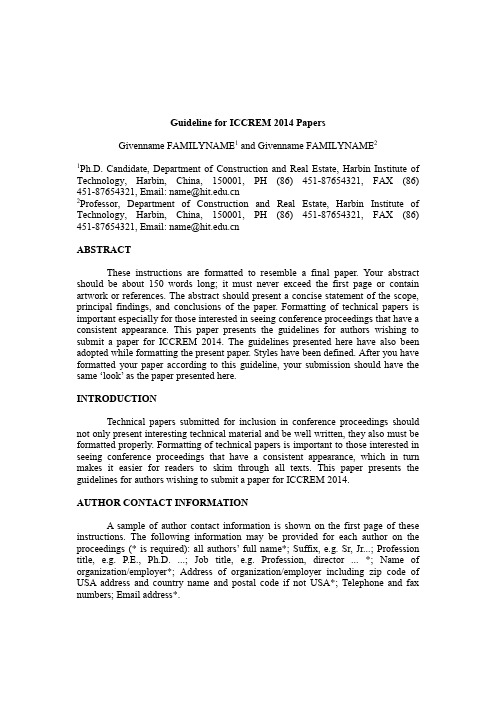
Guideline for ICCREM 2014 PapersGivenname FAMILYNAME1 and Givenname FAMILYNAME21Ph.D. Candidate, Department of Construction and Real Estate, Harbin Institute of Technology, Harbin, China, 150001, PH (86) 451-87654321, FAX (86) 451-87654321, Email: name@2Professor, Department of Construction and Real Estate, Harbin Institute of Technology, Harbin, China, 150001, PH (86) 451-87654321, FAX (86) 451-87654321, Email: name@ABSTRACTThese instructions are formatted to resemble a final paper. Your abstract should be about 150 words long; it must never exceed the first page or contain artwork or references. The abstract should present a concise statement of the scope, principal findings, and conclusions of the paper.Formatting of technical papers is important especially for those interested in seeing conference proceedings that have a consistent appearance. This paper presents the guidelines for authors wishing to submit a paper for ICCREM 2014. The guidelines presented here have also been adopted while formatting the present paper. Styles have been defined. After you have formatted your paper according to this guideline, your submission should have the same …look‟ as the paper presented here.INTRODUCTIONTechnical papers submitted for inclusion in conference proceedings should not only present interesting technical material and be well written, they also must be formatted properly. Formatting of technical papers is important to those interested in seeing conference proceedings that have a consistent appearance, which in turn makes it easier for readers to skim through all texts. This paper presents the guidelines for authors wishing to submit a paper for ICCREM 2014.AUTHOR CONTACT INFORMATIONA sample of author contact information is shown on the first page of these instructions. The following information may be provided for each author on the proceedings (* is required): all authors‟ full name*; Suffix, e.g. Sr, Jr...; Profession title, e.g. P.E., Ph.D. ...; Job title, e.g. Profession, director ... *; Name of organization/employer*; Address of organization/employer including zip code of USA address and country name and postal code if not USA*; Telephone and fax numbers; Email address*.FORMATTING REQUIREMENTSLength.Paper length as determined by your conference technical chair includes all text, graphics, and appendices. Please limit abstract to first page of paper.Point size and e 12 point type for text, captions, and author contact information. For type within figures or tables, the 12 point size is preferred. We recommend selecting a serif text font such as “Times”. Italics, bold, and bold italics may be used; we recommend sticking to one “family” of typefaces. Try to avoid the use of Arial fonts as these can be distorted in the conversion to pdf.Layout.All text must be single-spaced. Page design should be consistent throughout the paper.Margin settings (see below) must contain all elements of the paper that will be reproduced (text, figures, tables, captions). Short pages are unsightly and waste space; try to fill the imaginary box on each page. Leave at least 1" (3 cm) top and bottom margins. The first page of the paper should be an additional .5" below the top margin.Table 1.Margin Settings.Margins 8.5 x 11 (letter) A4Top 1" 3.5 cmBottom 1" 3.5 cmLeft 1.38" 3.25 cmRight 1.38" 3.25 cmStyle.The paper must be written in the best possible technical and grammatical English. Titles should be concise and should describe the content of the paper. If you have a long title, please consider a Title: Subtitle format.(1) Mathematics. All mathematics must be embedded in the text. Equations need to be numbered only if they are referred to more than once.(2) System of units. For more information about SI units, go to the U.S. Metric Association (USMA), Inc. site (/%7Ehillger/) or the National Institute of Standards and Technology (NIST) site (/cuu/Units/index.html).Figures and tables.All graphics (photos, line art, and tables) must fit within the above margin settings. All graphics should be understandable when printed in black and white. Do not use only color as a distinguishing feature. Use symbols or patterns on line and bar graphs to identify lines and columns. Landscape orientation is acceptable. Use 12 point type “Times” for text and captions in figures and tables.Illustrations should be numbered consecutively as they are presented (Figure 1, Figure 2, etc., and Table 1, Table 2, etc.). Each figure should be mentioned or called out before it appears. More than one figure may appear on a page.Captions and legends. A descriptive caption, including figure number, should be placed directly below the illustration (see Figure 1). A descriptive legend, including table number, should be placed immediately above the table (see Table 1).Figure 1.Sample line art illustration.References.All references should appear together at the end of the paper (see below). List all authors in the order given in the source document, then sort references in alphabetical order by authors. References are listed alphabetically by last name of the first author. When two or more references by the same author are listed, year of publication is taken into account, and the earliest work is listed first. Wherever reference is made in the text to an author‟s work, the author‟s name and year of publication should appear in parentheses. We strongly recommend that superscripts not be used to denote references, as these numbers often appear too small to be read easily. All listed references must be cited in text. See samples below.Example references are provided in the References section of this paper and they are cited in the next text. The proceedings of the first three IGLC conferences were compiled into a book, edited by Burka (1993). Valuable knowledge can also be found in other books (ICBO1997), doctoral dissertations (Kurtz 1991), technical reports (Fisher and Struik 1974), proceedings (Mossberg 1993; Pennoni 1992), and, of course, journal papers (Tommelein et al. 1999).COPYRIGHT TRANSFERNo paper can be included in an ASCE publication unless the author has agreed to the terms in the ASCE Authorship, Originality, and Copyright Transfer Agreement. A faxed signed CTA is OK. For more information see /Content.aspx?id=29630.PERMISSIONSIf a figure, photograph, or table has been published previously, the author must obtain written approval from the original publisher.Photos, figures, or other graphic elements and especially material taken from the internet is often copyrighted and cannot be reproduced without permission. For more information on Permissions see /Content.aspx?id=29631.CONCLUSIONIt is the author‟s responsibility to obtain necessary approv als from the author‟s employer prior to submission of paper s. Once a paper has been uploaded, reviewed by author, and officially submitted, it is not possible to edit the document.With thanks for your efforts, we look forward to providing a record of this conference that will be useful to you and your colleagues for many years to come. ACKNOWLEDGMENTSKindly thank Prof. Yong BAI providing a formatting template. We are also glad to have completed this set of formatting instructions and hope they are clear. If not, please let us know. We would like to thank in advance all authors who follow these guidelines diligently.REFERENCESBurka, L.P. (1993). “A hypertext history of multi-user dimensions.”</home/lpb/mud-history.html>(Dec. 5, 1994). Fisher, J.W., and Struik, J.H.A. (1974) Guide to design criteria for bolted and riveted joints, Wiley, New York.International Conference of Building Officials (ICBO). (1997). Uniform building code, Whittier, Calif.Kurtz, M. (1991). “Section 7: Transformation of space in computer graphics.”Handbook of applied mathematics for engineers and scientists, McGraw-Hill, New York, 7.1-7.42.Mossberg, W.S. (1993). “Word isn’t perfect but new WordPerfect is too much for words.” Wall Street J., Dec. 2, B1Pen noni, C.R. (1992). “Visioning: The future of civil engineering.” J. Profl. Issues in Engrg. Educ. AndPract., ASCE, 118(3), 221-233.Tommelein, I.D., Riley, D. and Howell, G.A. (1999). “Parade game: impact of work flow variability on trade performance.” Journal of Construction Engineering and Management, 125(5), 304-310.ICCREM 2014论文编排格式说明一、页面设置:(注:一定使用MS Office Word 2003 or 2007版本!)1、页边距:上3.5cm,下3.5,左3.25cm,右3.25cm。
会议论文提交和评审要求

会议论文提交和评审要求随着学术交流的不断发展,学术会议成为学者们展示研究成果、交流学术观点的重要平台。
然而,对于初次参加学术会议的研究者来说,会议论文的提交和评审要求可能会令人感到困惑。
本文将介绍会议论文提交和评审的一般要求,帮助读者更好地准备和撰写会议论文。
一、会议论文提交要求1. 投稿截止日期:在选择参加学术会议时,研究者需要关注会议的投稿截止日期。
一般而言,会议主办方会提前数个月公布会议举办时间和投稿截止日期。
因此,研究者需要提前规划和组织研究工作,确保在截止日期前完成论文撰写和准备。
2. 论文格式要求:不同学术会议可能对论文格式有不同的要求,如字体、字号、行间距等。
研究者需要仔细阅读会议官方网站上的论文格式指南,并按照要求进行排版和格式调整。
此外,还需要注意论文长度的要求,确保论文在规定字数范围内。
3. 论文内容要求:会议论文的内容应当与会议主题相关,并具有一定的创新性和学术价值。
研究者需要仔细阅读会议的征稿通知,了解会议的研究方向和重点,然后选择合适的研究课题进行论文撰写。
同时,还需要确保论文的逻辑结构清晰,研究方法合理,实验数据可靠,结论明确。
4. 论文语言要求:大部分学术会议要求论文使用英语撰写,因为英语是国际学术交流的通用语言。
研究者需要具备一定的英语写作能力,确保论文的语法、拼写和表达准确无误。
此外,还需要注意避免使用过于复杂的句子和术语,以便读者能够理解和接受论文内容。
二、会议论文评审要求1. 匿名评审:大部分学术会议采用匿名评审制度,即评审专家不知道论文作者的身份。
这样可以确保评审过程的公正性和客观性。
因此,研究者在提交论文时,需要删除论文中的作者信息,以免影响评审结果。
2. 评审标准:不同学术会议可能有不同的评审标准,但一般都包括原创性、学术质量、实证研究和创新性等方面。
评审专家会根据这些标准对论文进行评价和打分。
因此,研究者需要在撰写论文时,注重研究方法的科学性和可行性,确保论文的学术质量和创新性。
- 1、下载文档前请自行甄别文档内容的完整性,平台不提供额外的编辑、内容补充、找答案等附加服务。
- 2、"仅部分预览"的文档,不可在线预览部分如存在完整性等问题,可反馈申请退款(可完整预览的文档不适用该条件!)。
- 3、如文档侵犯您的权益,请联系客服反馈,我们会尽快为您处理(人工客服工作时间:9:00-18:30)。
国际会议论文排版及格式要求论文构成及顺序:Title(题目)→Authors(作者)→Affiliations(单位)→Abstract(摘要)→Keywords(关键词)→Text(正文)→Acknowledgement (致谢)→References(参考文献)排版软件:Word 2000以上版本纸型:A4 方向:纵向页面设置:页边距:上2厘米,下2厘米,左2厘米,右2厘米,页眉1.5厘米,页脚1.75厘米文档网格:选中“只指定行网格”,每页46行,跨度15.6磅,栏数:1,应用于:整篇文档整篇文档段落设置:间距:段前0行,段后0行行距:固定值,12磅(题目行、公式行用单倍行距)选中“如果定义了文档网格,则自动调整右缩进”和“如果定义了文档网格,则与网格对齐”单位与摘要间、关键词与正文间、正文与参考文献间空1行图、表前后空一行各级标题前后不空行字符间距设置:缩放:100%间距:标准位置:标准选中“调整字体的字间距”:1 选中“如果定义了文档网格,则对齐网格”字体和字号:题目:Times New Roman字体,四号,居中,加粗,所有实词首字母大写作者:Times New Roman字体,五号,居中,姓所有字母大写,名首字母大写作者单位:Times New Roman字体,小五号,不同单位间用分号分隔,居中,要标明二级单位(大学:院系;研究院所:处、室等),居中,多单位在作者右上角标阿拉伯数字区分摘要和关键词:Times New Roman字体,六号;关键词间用分号分隔;关键词首字母小写,关键词3~8个一级标题:五号,Times New Roman字体,加粗,所有实词首字母大写;靠左顶格二级标题:小五号,Times New Roman字体,加粗,所有实词首字母大写;靠左顶格三级标题:小五号,Times New Roman字体,第一个词首字母大写;靠左顶格正文部分:小五号,Times New Roman字体;希腊字母用Symbol字体图题、表题:小五号,加粗,Times New Roman字体;第一个词首字母大写;图序、表序用Fig.1、Table 1图、表中文字用小5号Times New Roman字体,量与单位之间用“/”间隔图注与说明、表注与说明:小五号Times New Roman字体参考文献:Times New Roman字体,六号图格式:1)图序与图题间空2格,其间不用任何点号。
2)图序和图题排在图的下方,整幅图左右居中,其总体长度不超过图面的宽度;否则图题应转行排。
3)几幅图形共用一个图序和图题,每幅图应有子图序,如(a),(b),(c)等,有时可能会有子图题。
子图序和子图题置于横标目的下方,相对于横坐标轴整个居中排;有时可置于图面内空白较大的地方,每个子图序和子图题在各个图面中的位置应一致。
4)标目中,量符号与单位符号间用斜分数线(/)相隔。
标目中的量符号与正文中的一致。
5)图注与说明安排在图题的上方。
6)先见文字叙述,后见图。
7)图不要与文字混排,图单独通栏排。
表格式:1)采用三线表。
2)表序与表题之间空2格,其间不用任何点号。
3)表身内无数字的栏内,应区别情况对待。
“空白”代表未测或未发现,“—”(一字线)或“…”代表无此项(即客观上不存在),“0”代表实测结果为零。
4)先见文字叙述,后见表格。
5)表不要与文字混排,表单独通栏排。
方程式、表达式编号:文中所列方程式、表达式必须按顺序编号(如:(1)),编号位置靠右顶格。
方程式、表达式居中排。
所有物理量的符号必须用斜体;单位必须用国际单位制(SI),必须使用正体。
其他说明:1)整篇文档不分节。
2)不加页码。
3)不加页眉。
4)文中不要作图文框。
5)各级标题上不能标注文献。
6)“基金项目”放在首页页脚(word中操作:插入“脚注和尾注”),给出项目编号。
7)英文中没有“。
”(应该用“.”)、“、”(应该用“, ”)、“~”(应该用“–”)、“《》”(应该用斜体)等标点符号。
参考文献:1)文中引用的参考文献必须在引用处右上角标注,如:[1]、[1,5,8]、[2-5]。
2)参考文献在文后用英文著录,著录格式见规定格式(顺序编码制),六号Times New Roman字体;中文文献标“in Chinese”,日文文献标“in Japanese”,其他语种同。
3)文献作者全部列出。
应姓前名后,姓、名首字母大写,姓、名之间不用逗号。
名可缩写,不加缩写点“.”。
4)未出版,非正式、公开出版的书、刊等不能作为参考文献。
5)期刊刊名可以缩写,不加缩写点。
刊名缩写应遵循ISO 4—1984《文献工作——出版物题名用语和题目的缩写规则》的规定。
6)引用一次文献。
附:参考文献著录内容要求及示例1 专著、书籍【格式】序号责任者. 书名. 其他责任者(如编者、译者,供选择). 版本(第1版不写). 出版地: 出版者, 出版年. 页码[1]Bird R B, Stewart W E, Lightfoot E N. Transport Phenomena. New York: John Wiley & Sons Inc, 1960. 75[2]Burton J J, Garten R L. New Catalytic Materials. Lin Xiping, tran. Beijing: Petroleum Industry Press, 1984. 45(in Chinese)2 期刊论文【格式】序号析出责任者. 析出题名. 刊名, 出版年, 卷号(期号): 起止页码[1]Henry R C, Lewis C W, Collins J F. Vehicle-related hydrocarbon source compositions from ambient data: the GRACE/SAFER method.Eniron Sci Technol, 1994, 28(5): 823-832[2]Liu Xiaoli, Li Hongzhi. An experimental investigation of deflagration to detonation transition (DDT) in aluminum dust-air mixture.Explosion and Shock Waves, 1996, 15(3): 217-228(in Chinese)3 会议论文【格式】序号析出责任者. 析出题名. In: 文集编者(后加ed或eds). 文集名. (供选项: 会议名, 会址, 开会年.)出版地: 出版者, 出版年. 起止页码[1]Ma Tingxi, Lu Xueshu. Computer aided analysis of the penetration of mounted tillage implement. In: Zhang Wei, Guo Peiyu, ZhangSenwen, eds. Agricultural Engineering and Rural Development: Vol I. Beijing: International Academic Publishers, 1992. 157-160(in Chinese)[2]Lauchi A. Cacium, salinity and the plasma membrane. In: Leonard R T, Hepler R K, eds. Plant Growth and Development. The AmericanSociety of Plant Physiologies Symposium Series. Rokville MD, 1990. 26-354 学位论文【格式】序号责任者. 题名. 硕士或博士论文. 学位授予地: 学位授予单位, 年份[1]Young L C. The Application of Orthogonal Collocation to Laminar Flow Heat and Mass Transfer in Monolith Converters. Ms D Thesis.Washington: University of Washington, 1974[2]Wang Yajun. Study on Monolithic Catalyst and Catalytic Converter. Ph D Thesis. Beijing: Beijing Institute of Technology, 2000(inChinese)5 专利【格式】序号专利申请者. 专利题名. 专利国别(或地区). 专利号. 出版日期[1]Larsen C E, Trip R, Johnson C R. Methods for Procedures Related to the Electrophysiology of the heart. US Patent 5 529 067. 1995-01-25[2]Zhang F M, Shu X T, Shi Z C, Wang W D, Qin F M, Wang X Q. A Pentasil-type Molecular Sieve Containing Composition and ItsPreparation Method. CN 1211469A, 1998(in Chinese)6 报纸【格式】序号责任者. 题目. 报纸名. 出版日期(版次)[1]Xie Xide. Creating new way to study. People’s Daily, 1998-12-25(10)(in Chinese)[2]Specter R B. CFCs may be destroyed by natural process. Washington Post, 1989-08-07(Sect A: 2)7 科技报告【格式】序号责任者. 报告题目. 报告号. 出版地: 出版者, 出版年[1]Gough P S. Theoretical Modeling of the Interior Ballistics of the Electrothermal Gun. AD-A268583, 1993[2]Chescheir G M, Westerman P W. Rapid Methods for Determining Fertilizer Value of Livestock Manures. ASAE paper No.84-4082.Michigan: American Society of Agricultural Engineering, 19848 标准【格式】序号责任者. 标准名. 标准编号. 出版年[1]APHE. Standard Methods for Examination of Water and Wastewater. American Public Health Association, Washington, DC, 1985[2]State Environmental Protection Administration of China. Standard of Environmental Noise of Urban Area. GB 3096-93, 1993(in Chinese) 7 电子文献【格式】序号责任者. 文献题名. 出处或可获得地址, 发表或更新日期/引用日期[1]Ministry of Water Resources of the People’s Republic of China. China Water Resources Bulletin: 2001. , 2002[2]Chaplin M. Guar gum. /water/hygua.html, 2003。
